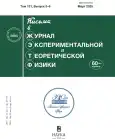Exact relations between running of αs and α in N = 1 SQCD + SQED
- Authors: Kataev A.L1,2, Stepanyantz K.V3
-
Affiliations:
- Institute for Nuclear Research of the Russian Academy of Sciences
- Bogoliubov Laboratory of Theoretical Physics, Joint Institute for Nuclear Research
- Moscow State University
- Issue: Vol 121, No 5-6 (2025)
- Pages: 337-339
- Section: Articles
- URL: https://bakhtiniada.ru/0370-274X/article/view/286575
- DOI: https://doi.org/10.31857/S0370274X25030019
- EDN: https://elibrary.ru/PQGVDL
- ID: 286575
Cite item
Abstract
In N = 1 supersymmetric QCD and QED theory we derive the (all-order) exact equations relating the renormalization group behaviour of the strong and electromagnetic couplings and prove that they are valid in the combined higher covariant derivative regularized and minimal subtraction of logarithms renormalized prescription. In particular, the β-function of N = 1 supersymmetric QCD can be expressed in terms of the Adler D-function. If all flavors have the same absolute value of the electromagnetic charges, it is also possible to write a simple relation between the β-functions for the strong and electromagnetic coupling constants. In this particular case there is a special renormalization group invariant relation.
About the authors
A. L Kataev
Institute for Nuclear Research of the Russian Academy of Sciences; Bogoliubov Laboratory of Theoretical Physics, Joint Institute for Nuclear Research
Email: kataev@ms2.inr.ac.ru
Moscow, Russia; Dubna, Russia
K. V Stepanyantz
Moscow State University
Author for correspondence.
Email: kataev@ms2.inr.ac.ru
Moscow, Russia
References
- E. C. G. Stueckelberg de Breidenbach and A. Petermann, Helv. Phys. Acta 26, 499 (1953).
- M. Gell-Mann and F. E. Low, Phys. Rev. 95, 1300(1954).
- N. N. Bogolyubov and D. V. Shirkov, Nuovo Cim. 3, 845(1956).
- S. L. Adler, Phys. Rev. D 10, 3714 (1974).
- V. A. Novikov, M. A. Shifman, A. I. Vainshtein, and V. I. Zakharov, Nucl. Phys. B 229, 381 (1983).
- D. R. T. Jones, Phys. Lett. B 123, 45 (1983).
- I. Jack, D. R. T. Jones, and C. G. North, Nucl. Phys. B 486, 479 (1997); arXiv:hepph/9609325 [hep-ph]].
- D. I. Kazakov, JETP Lett. 41, 335 (1985).
- A. A. Slavnov, Nucl. Phys. B 31, 301 (1971).
- A. A. Slavnov, Teor. Mat. Fiz. 13, 174 (1972) [Theor. Math. Phys. 13, 1064 (1972)].
- A. L. Kataev and K. V. Stepanyantz, Nucl. Phys. B 875, 459 (2013); arXiv:1305.7094 [hep-th].
- I. O. Goriachuk, A. L. Kataev, and K. V. Stepanyantz, Phys. Lett. B 785, 561 (2018); arXiv:1808.02050 [hep-th].
- I. O. Goriachuk and A. L. Kataev, JETP Lett. 111(12), 663 (2020); arXiv:2005.03445 [hep-th].
- M. Shifman and K. Stepanyantz, Phys. Rev. Lett. 114(5), 051601 (2015); arXiv:1412.3382 [hep-th].
- M. Shifman and K. V. Stepanyantz, Phys. Rev. D 91, 105008 (2015); arXiv:1502.06655 [hep-th].
- A. I. Vainshtein, V. I. Zakharov, and M. A. Shifman, Pis’ma v ZhETF 42, 182 (1985) [JETP Lett. 42, 224 (1985)].
- M. A. Shifman, A. I. Vainshtein, and V. I. Zakharov, Phys. Lett. B 166, 334 (1986).
- D. Korneev, D. Plotnikov, K. Stepanyantz, and N. Tereshina, JHEP 10, 046 (2021); arXiv:2108.05026 [hep-th].
- O. Haneychuk, V. Shirokova, and K. Stepanyantz, JHEP 09, 189 (2022); arXiv:2207.11944 [hep-ph].
- K. V. Stepanyantz, Nucl. Phys. B 852, 71 (2011); arXiv:1102.3772 [hep-th].
- A. V. Smilga and A. Vainshtein, Nucl. Phys. B 704, 445 (2005); arXiv:hep-th/0405142 [hep-th].
- A. A. Vladimirov, Sov. J. Nucl. Phys. 31, 558 (1980).
- A. L. Kataev, A. E. Kazantsev, and K. V. Stepanyantz, Nucl. Phys. B 926, 295 (2018); arXiv:1710.03941 [hep-th].
- C. Bonanno, P. Butti, M. Garc´ıa P´erez, A. Gonz´alezArroyo, K. I. Ishikawa, and M. Okawa, Phys. Rev. D 110(7), 074507 (2024); arXiv:2406.08995 [hep-th].
Supplementary files










